The Running Man Nebula is a reflection nebula embedded in the larger H II region Sharpless 279 (Sh2-279). It lies 1,500 light-years away in the constellation Orion. The nebula is part of the asterism known as Orion’s Sword, along with its brighter and larger neighbour, the Orion Nebula (M42).
The Running Man Nebula got its popular nickname because its shape resembles the figure of a running man. The nebula’s unique appearance and proximity to the larger Orion Nebula make it a popular astrophotography target. The two nebulae appear in the same field of view and are frequently photographed together.
While the Orion Nebula is visible even without binoculars, the outline of the running man in the Running Man Nebula is a difficult target for amateur telescopes. It is best seen photographically. The reflection nebula itself can be glimpsed in small and medium telescopes.
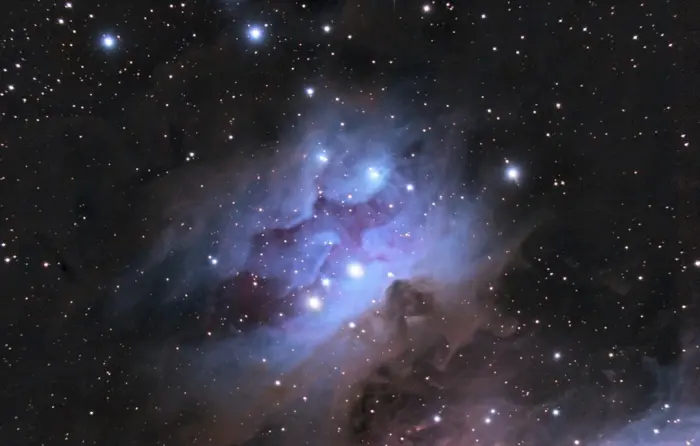
The Running Man Nebula (NGC 1977), image credit: Radan Mitroviќ (CC BY-SA 4.0)
The whole Running Man Nebula is believed to be illuminated and excited by 42 Orionis, a hot young stellar object located within the nebula. 42 Orionis has the stellar classification B1V and is also catalogued as c Orionis and HD 37018.
The star has a mass 12 times that of the Sun and a surface temperature of 25,400 K. It is in fact a triple star system. The primary component has two companions. One is a close spectroscopic companion at a separation of only 0.16 arcseconds and the other is a magnitude 7.5 star separated by 1.6 arcseconds from the primary. The system shines at magnitude 4.59.
In images, 42 Orionis appears 3.8 arcminutes from the centre of Sh2-279. The nebula is home to other massive young stars, including 45 Orionis, a yellow giant or subgiant, and the variable B-type star KX Orionis.
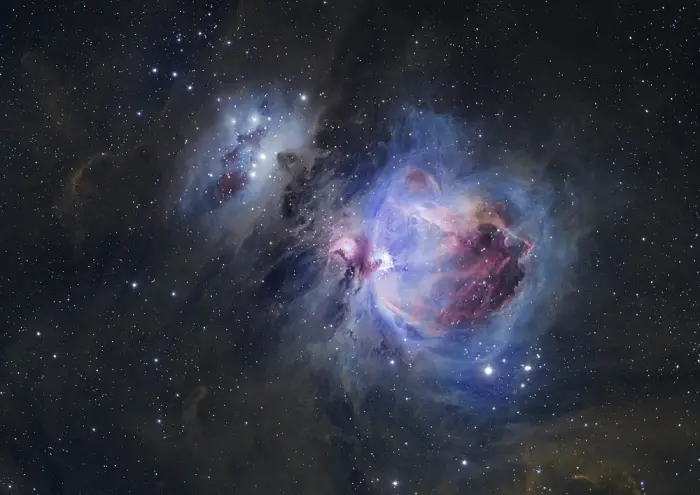
Orion Nebula and the Running Man Nebula with surrounding nebulosity. Composite of narrowband (SII + Ha =OIII) and RGB with a 80mm telescope. Image credit: Stephan Hamel (CC BY-SA 4.0)
Sharpless 279
The star-forming region Sh2-279 consists of the reflection nebulae NGC 1973, NGC 1975, and NGC 1977, and the open cluster NGC 1981. The Running Man Nebula is commonly associated with the New General Catalogue designation NGC 1977, which refers to the reflection nebulosity around the star 42 Orionis (c Orionis) in the southeastern part of Sh2-279. The designation is sometimes used for the whole nebula complex.
NGC 1977 is the brightest and largest nebula in Sh2-279. It has a radius of 7.5 light-years. It was discovered by the German-born British astronomer William Herschel in 1786. Herschel catalogued the object as “H V 30” with a note “42 Orionis and neb[ula].”
NGC 1973 and NGC 1975 were discovered by German astronomer Heinrich Louis d’Arrest, director of the Østervold Observatory at the University in Copenhagen, in 1862 and 1864.
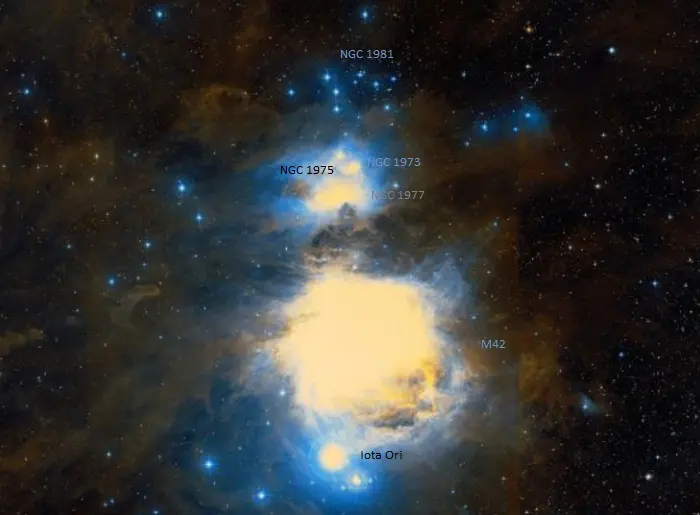
Sharpless 279 (Sh2-279), image: Wikisky
The nebula NGC 1975 has a radius of 2 light-years, and NGC 1973 is the smallest of the three nebulae with a radius of 1 light-year. The nebulae are separated by darker lanes of dust that form the figure of the running man in the sky.
NGC 1973, NGC 1975, and NGC 1977 were included in the New General Catalogue in 1888.
The open cluster NGC 1981 (Collinder 73) was discovered by John Herschel, son of William, on January 4, 1827. The cluster has an apparent magnitude of 4.2 and stretches across 28 arcminutes.
Facts
The reflection nebulae NGC 1973, NGC 1975 and NGC 1977 are associated with the Orion Molecular Cloud Complex, a vast star-forming region that stretches across most of the constellation Orion.
The Running Man Nebula is sometimes called the Ghost Nebula because its shape resembles that of a cartoon ghost. It should not, however, be confused with the Ghost Nebula (Sh2-136), a spooky-looking nebula in the constellation Cepheus.
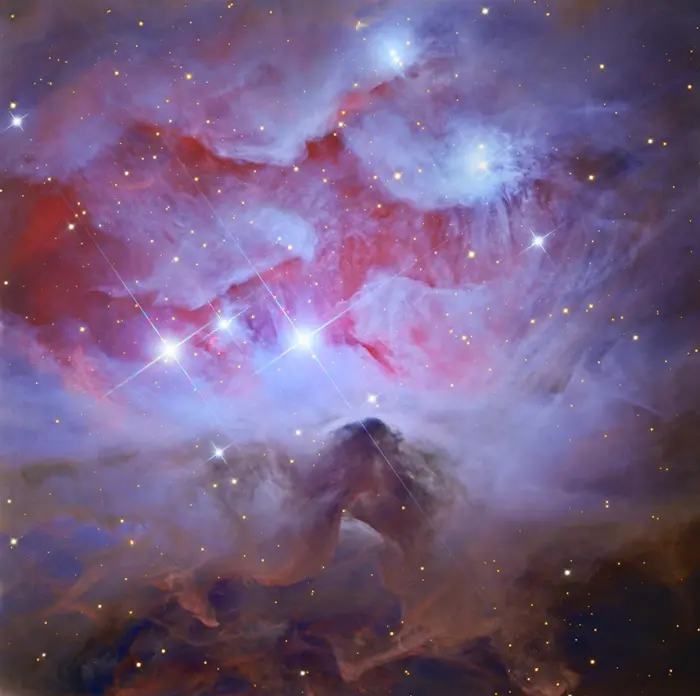
The Running Man Nebula, credit: Adam Block/Mount Lemmon SkyCenter/University of Arizona. Optics: 32-inch Schulman Telescope (RCOS). Camera: SBIG STX16803 CCD. Camera: Filters Astrodon Gen II. Date: November – December 2015. Location: Mount Lemmon SkyCenter. Exposure: RGB = 7 : 7 : 7 Hours Acquisition Astronomer Control Panel (ACP), Maxim DL/CCD (Cyanogen), FlatMan XL (Alnitak). Processing CCDStack, Photoshop CC, PixInsight. (CC BY-SA 4.0)
Observations with the Hubble Space Telescope in 2012 revealed a candidate proplyd (ionized protoplanetary disk) in the nebula NGC 1977. The proplyd had a bent protostellar jet and a possible ionization front facing 42 Orionis.
Proplyds are photoevaporating protoplanetary disks found around very young stars. Almost 180 of these objects have been detected in the Orion Nebula, the nearest region of massive star formation to the Sun.
The Running Man Nebula contains the largest number of known proplyds outside the Orion Nebula. Seven of these objects have been confirmed so far. Six were discovered with the Hubble Space Telescope and one with the infrared Spitzer Space Telescope in 2016. All seven are within 1 parsec of 42 Orionis and are pointing in the direction of the star, which is the common ionizing source.
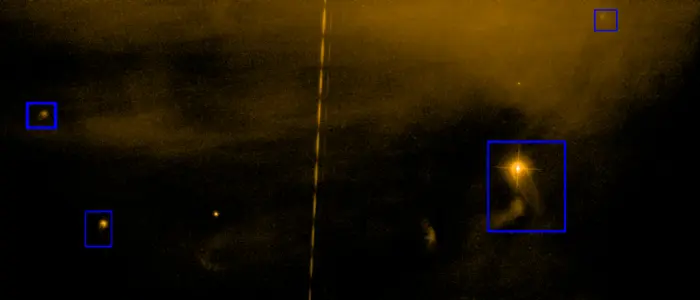
Kim et al. 2016 discovered proplyds in NGC 1977 with the Hubble Space Telescope. These proto-planetary disks (proplyds) are being photoevaporated by 42 Orionis. This work uses data from the NASA/ESA Hubble Space Telescope Proposal 12250. Credit: NASA/ESA Hubble Space Telescope Proposal 12250 (CC BY-SA 4.0)
The discovery of the proplyds in NGC 1977 was the first time that astronomers found an instance where a B-type star was causing the photoevaporation of a proplyd. The ultraviolet radiation from 42 Orionis is eroding the protoplanetary disks, while the star’s strong stellar winds are carving the shapes of the gas into cometary tails. Six of the seven proplyds show tails pointing away from the star. Two of them have clearly resolved central sources that are associated with disks of radii between 50 and 70 astronomical units.
In 2021, astronomers reported the discovery of a swift stellar jet from a newly formed star in NGC 1977. The young star Parengo 2042 (P2042) was detected with NASA’s Hubble Space Telescope. The star is shrouded in a disk of debris in which planets may form in the future. It is responsible for powering a jet of plasma that stretches 2 light-years across. The gas in the jet is ionized by the radiation of a nearby star, 42 Orionis.
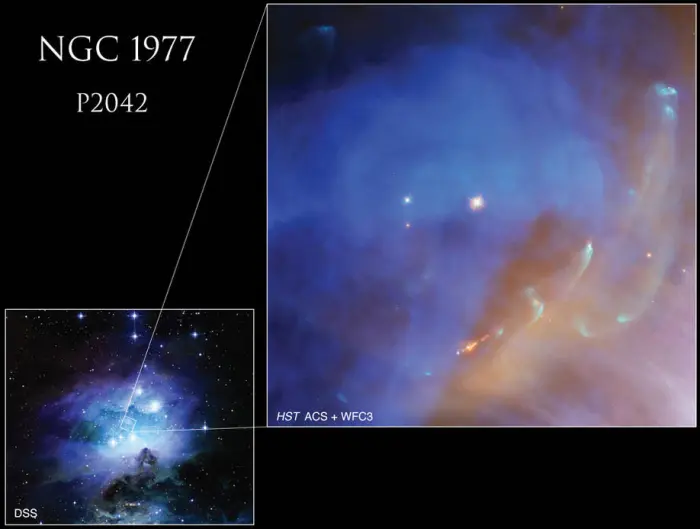
A jet from a newly formed star flares into the shining depths of reflection nebula NGC 1977 in this Hubble image. The jet (the orange object at the bottom center of the image) is being emitted by the young star Parengo 2042, which is embedded in a disk of debris that could give rise to planets. The star powers a pulsing jet of plasma that stretches over two light-years through space, bending to the north in this image. The gas of the jet has been ionized until it glows by the radiation of a nearby star, 42 Orionis. This makes it particularly useful to researchers because its outflow remains visible under the ionizing radiation of nearby stars. Typically the outflow of jets like this would only be visible as it collided with surrounding material, creating bright shock waves that vanish as they cool. Image credit: NASA, ESA, J. Bally (University of Colorado at Boulder), and DSS; Processing: Gladys Kober (NASA/Catholic University of America)
While searching for stellar jets and planet-forming disks, Hubble also caught a Herbig-Haro object catalogued as HH 45 within NGC 1977. Herbig-Haro objects are small bright patches of nebulosity found around newly formed stars. They form when these stars eject narrow jets of partly ionized gas, which then collide with nearby dust and gas at several hundred kilometres per second. As they collide with clouds of dust and gas, the jets create bright shock waves.
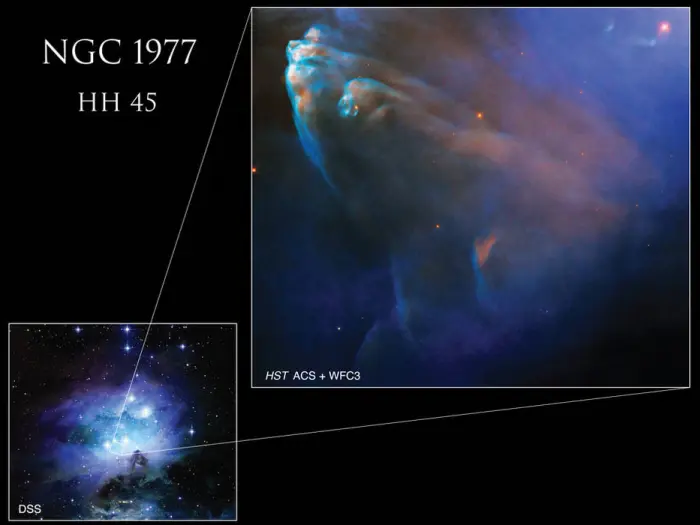
Mounded, luminous clouds of gas and dust glow in this Hubble image of a Herbig-Haro object known as HH 45. Herbig-Haro objects are a rarely seen type of nebula that occurs when hot gas ejected by a newborn star collides with the gas and dust around it at hundreds of miles per second, creating bright shock waves. In this image, blue indicates ionized oxygen (O II) and purple shows ionized magnesium (Mg II). Researchers were particularly interested in these elements because they can be used to identify shocks and ionization fronts. Image credit: NASA, ESA, and J. Bally (University of Colorado at Boulder); Processing: Gladys Kober (NASA/Catholic University of America)
Orion’s Sword
The Running Man Nebula is part of Orion’s Sword, one of the several conspicuous asterisms in the constellation Orion. Orion’s Sword is formed by 42 Orionis in the Running Man Nebula, the Theta Orionis system in the Orion Nebula (Messier 42), and the multiple star system Iota Orionis (Hatysa).
The region of Orion’s Sword forms the Orion OB1c subgroup of the Orion OB1 association. The stars of the Orion OB1c group – 42 Orionis, Theta Orionis, and Iota Orionis – have an estimated age between 3 and 6 million years.
Location
The Running Man Nebula is the northernmost point of light in Orion’s Sword, an asterism located just below the Belt of Orion. The nebula appears only 0.6 degrees north of the brighter and larger Orion Nebula (Messier 42).
Orion is visible for most of the year from both the northern and southern hemispheres. The constellation disappears below the horizon during the northern hemisphere early summer, only to reappear in the eastern sky before dawn in August.
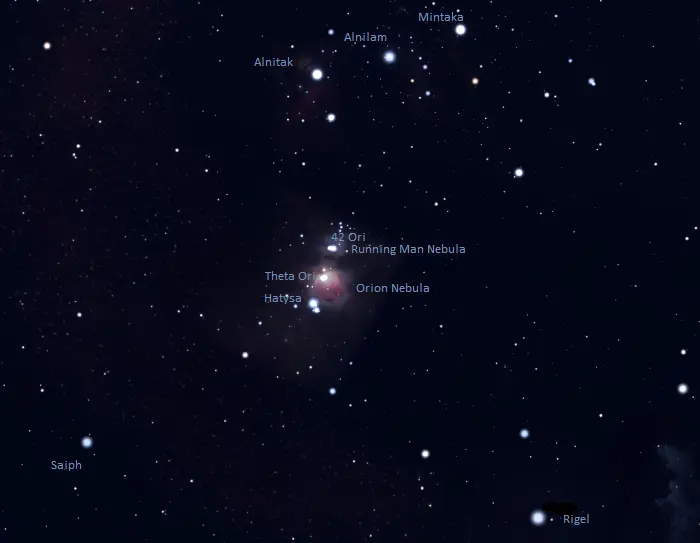
The location of the Running Man Nebula in Orion’s Sword, image: Stellarium
Orion dominates the evening sky from November to February. The best time of the year to observe the Running Man Nebula, the Orion Nebula, and other deep sky objects in the constellation is during the month of January, when the Hunter appears higher in the sky in the evening.
Running Man Nebula – NGC 1977
| Constellation | Orion |
| Right ascension | 05h 35m 16.2s |
| Declination | −04° 47′ 07″ |
| Apparent magnitude | 7.0 |
| Apparent size | 40 x 25 arcminutes |
| Radius | 7.5 light-years |
| Distance | 1,500 light-years |
| Names and designations | Running Man Nebula, NGC 1977, Sharpless 279, Sh2-279 |
IMAGES
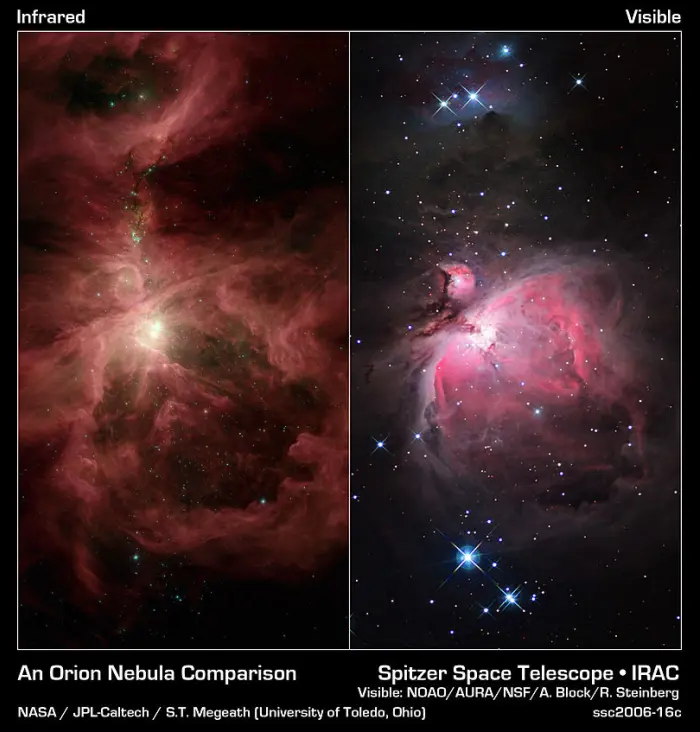
This image composite compares infrared and visible views of the famous Orion Nebula and its surrounding cloud, an industrious star-making region located near the Hunter constellation’s sword. The infrared picture is from NASA’s Spitzer Space Telescope, and the visible image is from the National Optical Astronomy Observatory, headquartered in Tucson, Ariz. In addition to Orion, two other nebulae can be seen in both pictures. The Orion Nebula, or M42, is the largest and takes up the lower half of the images; the small nebula to the upper left of Orion is called M43; and the medium-sized nebula at the top is NGC 1977. Each nebula is marked by a ring of dust that stands out in the infrared view. These rings make up the walls of cavities that are being excavated by radiation and winds from massive stars. The visible view of the nebulas shows gas heated by ultraviolet radiation from the massive stars. The infrared image shows light captured by Spitzer’s infrared array camera. Light with wavelengths of 8 and 5.8 microns (red and orange) comes mainly from dust that has been heated by starlight. Light of 4.5 microns (green) shows hot gas and dust; and light of 3.6 microns (blue) is from starlight.. Credit – Spitzer: NASA/JPL-Caltech/ T. Megeath (University of Toledo, Ohio)
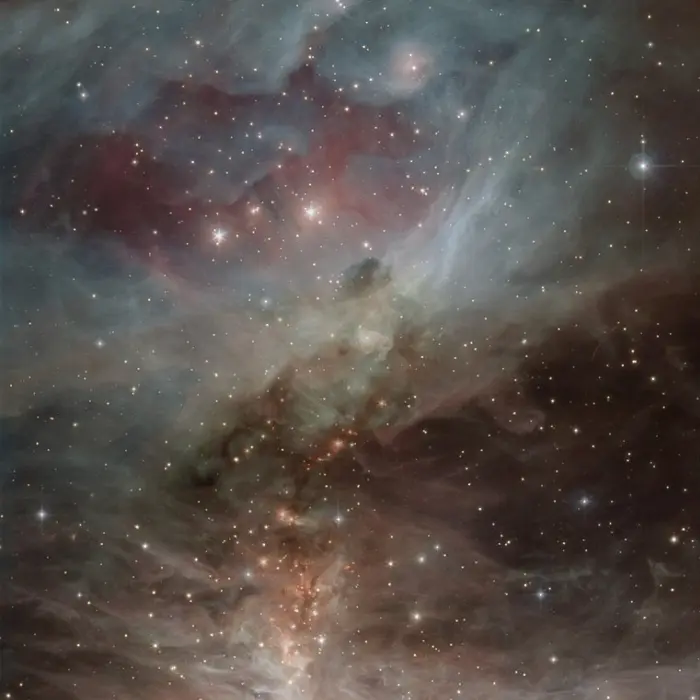
NGC 1973, 1975, 1977, credit: POSS II/Spitzer/WISE/Giuseppe Donatiello (CC0 1.0)
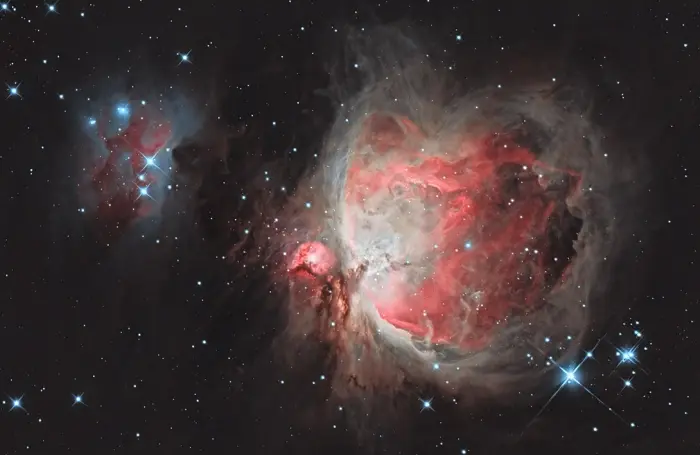
The Orion Nebula and the Running Man Nebula, image credit: Wikimedia Commons/Nielander. Mount: SkyWatcher EQ6R-PRO Guider: Starlight Xpress Lodestar Corrector: Baader MPCC Mark III Filter: Optolong L-eNhance Camera: Nikon D5600 (unmodified) Software for acquisition and processing: PHD2, APT, DeepSkyStacker, PixInsight, Photoshop. (CC BY-SA 4.0)